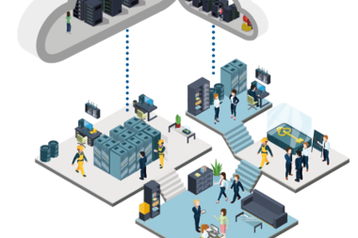As hybrid digital infrastructures consisting of on-premise and cloud-based systems become more and more common within companies, complexity significantly increases. This development has a massive impact on the management of data centers as infrastructures need to be seamlessly mapped and controlled to keep operations continuously running smoothly. A professional data center infrastructure management (DCIM) tool should be able to manage not only the data center itself, but also hybrid digital infrastructures in all their complexity. In the future, for example, even proprietary customer systems will have to be supplied with detailed information from the data center to ensure end-to-end processes.
Historically, DCIM software has been used in on-premise systems. Just five years ago, it was unthinkable for business-critical data to be transferred and stored in the cloud. Today, however, cloud based DCIM solutions are becoming increasingly popular to manage hybrid infrastructures holistically. By taking advantage of a SaaS operating model, or DCIM-as-a-Service (DCIMaaS), companies can utilize all services related to data center management more efficiently and with greater precision. Compared to an in-house solution, a SaaS model provides greater flexibility, offers a more holistic view of all IT and communications-related devices and components, and also reduces costs.
Legacy challenges
Digitalization has a profound impact on corporate IT processes and the underlying technical infrastructure. System landscapes are heterogeneous in structure and are usually made up of physical and virtualized components. Traditional IT architectures often show a mixture of state-of-the-art technologies and legacy systems with self-developed applications for business-critical processes. Additionally, many companies outsource parts of their IT resources to the cloud, resulting in a hybrid infrastructure consisting of on-premise systems and cloud-based operating models. Such landscapes are very complex, non-transparent, and difficult to administer.
In addition, information about the IT infrastructure is often still managed in silo architectures. This means that the data is often unstructured, available in various file formats, and is distributed across the company to numerous storage resources with different hierarchies. This makes it difficult to find, identify, and integrate information into a uniform data model. These redundancies can lead to inconsistent data sets and inevitably pose challenges for companies with regard to compliance regulations, especially the European Data Protection Regulation (DSGVO). Furthermore, companies are pressured to reduce costs across the board and increase the efficiency of processes.
The heterogeneous structures also affect one level below, namely the management of data centers. Here, in addition to the management of storage, server and network resources, the underlying infrastructure for cooling and power supply, as well as the optimal room layout are also important. IT managers often struggle with pain points as administrators may not have a sufficient overview of the running processes in the data center. In this case, there is no validated data on the current energy consumption and it isn’t possible to determine where concrete savings can be made. Similarly, there is often no transparency about the actual utilization of the cooling components, which reduces the efficiency of the processes. Furthermore, if data center room layouts are not optimized, cooling and exhaust air circuits of servers and storage systems may not function properly. This can cause hardware to become inefficient and not perform at its maximum capacity. There is also a risk that the available resources are not used optimally.
Digital strategy solutions
The market offers various categories of software systems for improving data center processes. IT consulting and analyst firms including 451 Research and Gartner have introduced concepts and software solutions for data center management. In particular, 451 Research uses the term Data Center Service Optimization (DCSO). These systems manage and optimize virtual and physical resources in the data center, including energy consumption and supply, provide an overview of the actual costs of data center services, and enable realistic cost and price models.
As DCIM and DCSO systems enable the seamless monitoring of data centers in real time, companies can plan and deploy resources more efficiently. The consumption and availability of power as well as current environmental conditions such as cooling and the status of infrastructure components and IT resources are all monitored. Through the well-founded analysis of all relevant parameters, capacities can be optimally provided and processes relating to room layout, power supply, cooling and availability of equipment can be perfected and automated. This allows companies to benefit from energy-efficient and cost-saving data center operations. DCIM systems thus close the gap between IT systems and facility components and holistically optimize data center processes.
In addition, the requirements for data center management are changing rapidly. As mentioned, hybrid digital infrastructures consisting of on-premise and cloud-based systems will become more and more common in companies - and significantly increase complexity. According to Gartner, this is one of the top ten trends in the field of IT infrastructure. This development has a massive impact on the management of data centers: In the future, increasingly complex infrastructures will have to be seamlessly mapped and controlled. At the same time, the continuous efficient and stable operation of all IT systems must be guaranteed. A professional DCIM tool should, therefore, be able to manage not only the data center itself, but also hybrid digital infrastructures in all their complexity. In the future, for example, even proprietary customer systems will have to be supplied with detailed information from the data center to ensure end-to-end processes.
Cloud adoption
Cloud computing is growing rapidly in around the world. According to Gartner, enterprise spending on cloud-based offerings will eclipse spending on non-cloud IT offerings by 2022, with platform as a service (PaaS) technologies — a broad collection of application infrastructure services — becoming the prevailing platform delivery model moving forward. Spending on cloud system infrastructure services is forecasted to grow to $63 billion by 2021.
While PaaS capabilities support the role of a cloud platform, all cloud services including infrastructure as a service (IaaS) and software as a service (SaaS) can play critical roles for a platform, Gartner reported. That means looking for and recognizing the opportunities for platform-based innovation across the entire spectrum of cloud services must be part of every cloud strategy, including data center infrastructure management.
Advantages of a SaaS Model
The advantages of the SaaS model, compared to in-house operations, are obvious – companies can flexibly and precisely use the range of functions and capacities for data center management that they actually need. This means that services booked can be adapted to the customer's specific requirements.
Additional services and functions can be added or removed as required and high costs for software licenses and maintenance are eliminated. Instead, the customer pays a monthly fee that includes all updates, upgrades and clearly defined services. Thanks to a contractually defined usage period and demand-oriented billing of the services used, companies benefit from maximum cost transparency and a high degree of financial planning security.
A further advantage is that the company's IT team no longer has to take care of the operation, updates or management of the application itself, but can place these tasks in professional, external hands - namely in the responsibility of the SaaS provider. This allows internal employees and administrators to concentrate more on their core tasks.
A holistic view of data center processes
Data center management not only includes IT resources such as servers, storage and network technologies, but also infrastructure components for power supply and cooling, ensuring efficient control of the entire architecture and mapping of processes. DCIMaaS offerings can take data center processes to a new level. This is achieved by gaining a holistic view of all IT and communications-related devices and components through documentation. Proper documentation enables all data center processes to be efficiently planned, managed, and, ultimately, automated.
A DCIMaaS solution can also provide capacity management to optimize floor space, power, and cooling within the data center and make optimal use of existing resources. This enables companies to manage their spatial and technical capacities in the data center more efficiently. As a result, the right resources are always available at the right time for all types of infrastructures. Lastly, connectivity management will ensure that all network connections within the data center are properly planned and managed. This includes cable infrastructure, auto-routing, and signal tracking capabilities to route new connections and ensure end-to-end connectivity.
Overall, in times of digitalization, data centers must be managed holistically. Modern DCIM systems close the gap between classic IT systems and the underlying infrastructure components such as power supply and cooling. By taking advantage of a SaaS operating model, companies can use all services related to data center management more efficiently and with greater precision.


